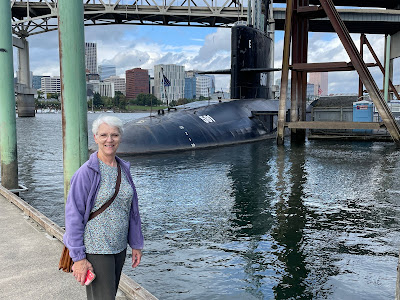We made it to Portland in time for the rain. Imagine that! Did it slow us down? No.
On the agenda was a visit to the Japanese Garden, International Rose Test Garden, and the Oregon Museum of Science and Industry. The Japanese Garden is closed for maintenance on Tuesdays so we immediately went next door to see the roses. They are both in Washington Park which is on a hill in Portland that overlooks the Willamette River. Though it was cloudy all day with rain on and off, the temperature was not a problem for us.
Some plants (the test ones) at the test garden are considered as specimens for testing and judging. Other plants are planted in quantity. That is, the award-winning roses that span a history of nearly 50 years of hybridization. They also have a wide variety of types. The most abundant is Hybrid Tea. Other types include English, Grandiflora, Floribunda, Knockout, Miniature, Climbing, and Tree roses. By the way, tree roses are based on a bush type grafted to a slow-growing tree trunk. The beds are well organized and well maintained. There’s even a listing of the inventory and a map that designates where each variety is grown. Everything is labeled, too. In spite of all this detail, it is still easy to get confused as to which rose you liked best and where it was located.
Our first stop, the International Rose Test Garden in Washington Park.
Though late in the year for roses, this place is still beautiful
with quite a spectacle of roses.
How about a composite of a few rose photos?
Having completed our jaunt through the roses, we headed down the hill to the Willamette River and the Oregon Museum of Science and Industry. At the museum we encountered many children. What was it? A free day? We never found out. But, once inside and after walking about we did see that nearly every exhibit was of the “hand-on” variety. That means it was designed with curious kids in mind.
Since we’re not kids anymore, we decided to pay the extra fee and take the tour of the submarine. The tour, unlike the WW II U-boat in Chicago, this was a guided tour that was about 45 minutes in length. In order to take the tour, we had to prove we could climb through a doorway since we would encounter two on the tour in the sub. We passed. For us, the tour of the SS-581 was the highlight of the museum.
We are preparing to board the USS Blueback for a tour of the submarine.
This photo was taken in the control and navigation room. We were
shown what it was like to be under “red light” conditions. When the
crew is underwater (away from daylight) for days at a time, the red
lighting serves two purposes. First, it helps the crew to know
the difference between day and night. Second, red is uses
at night because its light waves do not travel as far as white light
which can be reflected up the periscopes, etc. This makes the submarine
harder to see at night from the sea’s surface.
The sub can carry 18 torpedos. Six are stored in the tubes and
another dozen are held on storage racks. We also learned
a few things about the varieties of torpedoes.
This photo of of one of the control panels for monitoring the HVAC
system, the diesel engines, and the generators. Diesel-powered
subs can generate and store enough electricity (during a day on the surface)
to operate up to 4 and one-half days submerged.
Commonly referred to as the screw, this was the last propeller
used on the Blueback. It now stands at a memorial
to all submarines lost in service of the USA.








No comments:
Post a Comment